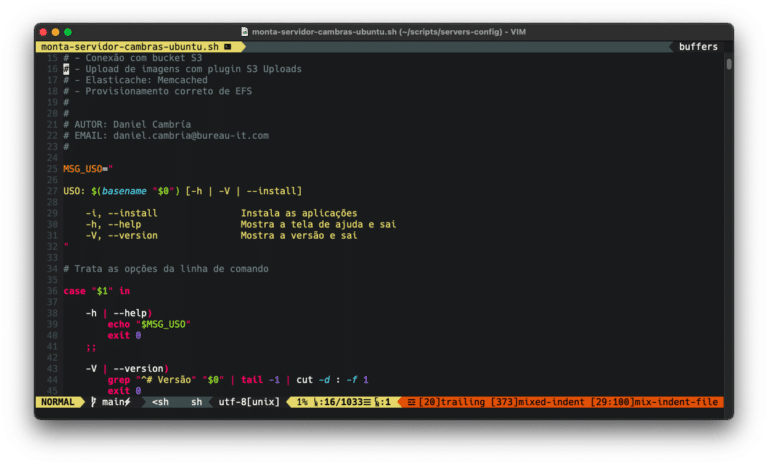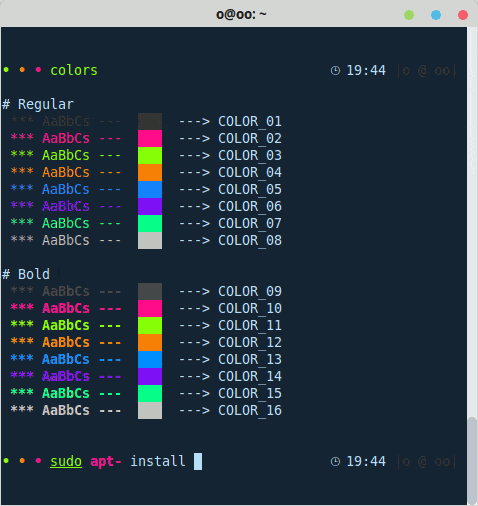Estimated reading time: 15 minutes
Modes of use
First things first.
To get started with bc, it’s important to know that there are two ways to use it: interactive or non-interactive.
Using the interactive mode is easy, just type in bc and start the commands.
$ bc bc 1.06 Copyright 1991-1994, 1997, 1998, 2000 Free Software Foundation, Inc. This is free software with ABSOLUTELY NO WARRANTY. For details type `warranty'. 1+1 2
In non-interactive mode, you need to pass a string to the bc’s stdin somehow. echo, printf, pipe, here strings… choose the most convenient one and go for it. Let’s look at some examples:
$ echo "10*10" | bc #via pipe 100
$ bc <<< "10-3" #via here strings 7
Variables
bc has 4 important variables that it uses internally:
ibase #base dos números de entrada (input) no cálculo obase #base do número do resultado (de saída, output) do cálculo scale #define a quantidade de dígitos após a vírgula após operações de divisão last #repete o último número calculado
You can also define your own variables, but always in lower case.
$ bc bc 1.06 Copyright 1991-1994, 1997, 1998, 2000 Free Software Foundation, Inc. This is free software with ABSOLUTELY NO WARRANTY. For details type `warranty'.a = 1 b = 2 c = a + b c 3
The bc does not tolerate upper cases in variables, but it does require upper cases for all hexadecimal entries! Be aware of this =)
Hexadecimal, decimal, octal, binary and similar conversions…
This calculator becomes even more interesting when we need to change bases. For example, to convert hexadecimal (base 16) to decimal (base 10), simply change the ibase (input) and obase (output) variables. Both are 10 by default. So let’s just change ibase, since the output will be decimal by default:
$ echo "ibase=16; FF" | bc 255
Or to convert from base 16 (hex) to base 2 (binary) with the arguments ibase (input) and obase (output) declared together:
$ echo "ibase=16; obase=2; FF" | bc 11111111
Operators
The basics:
+ addition
– subtraction
* multiplication
/ division
% remainder
^ power
Here’s bc in action with some commands and my comments alongside (yes, it accepts comments using # after each command).
To enter interactive mode, just call the command bc.
$ bc -q 10*10 #cálculo com base 10, default 100 ibase=16 #alteração do input para base 16 (hex) FF 255 #output de FF FF*2 510 #output de FF*2 obase=2 #troca a base do output para 2 (binário) FF 11111111 #resultado de FF FF*2 111111110 #resultado de FF*2 ibase=2 #troca base do input para 2 obase=A #troca base do output para 10 (escrito em hex). Aqui tem uma pegadinha, se colocar 10 o BC irá se perder. obase #chama a variável obase 10 #exibe o valor que consta na variável obase, igual no python 🙂 11111111 255 #resultado de 11111111 em decimal last #exibe o último resultado 255 scale=3 #define os dígitos após vírgula 23/3 7.666 quit #sai do bc interativo
Other functions
Need more? Logarithm, sine, cosine, tangent etc? Use the bc math library with the –mathlib option
$ bc --mathlib s(1) .84147098480789650665 c(1) .54030230586813971740 a(1) .78539816339744830961
And the bc can even make programs!
See this example from the bc manual, the check book.
Save the code below in any file, for example checkbook.bc
scale=2
print "\nCheck book program!\n"
print " Remember, deposits are negative transactions.\n"
print " Exit by a 0 transaction.\n\n"
print "Initial balance? "; bal = read()
bal /= 1
print "\n"
while (1) {
"current balance = "; bal
"transaction? "; trans = read()
if (trans == 0) break;
bal -= trans
bal /= 1
}
quit
Now run it.
$ bc -q checkbook.bc Check book program! Remember, deposits are negative transactions. Exit by a 0 transaction. Initial balance? 2 current balance = 2.00 transaction? 1 current balance = 1.00 transaction? 1 current balance = 0 transaction? 1 current balance = -1.00 transaction? 0 quit
There are many other functions in the bc, worth exploring if you want to delve into the subject. The bc manual is very interesting, certainly worth a look.
But before I end the article, take a look at this huge archive of bc functions!
#!/usr/local/bin/bc -l
### Funcs.BC - a large number of functions for use with GNU BC
## Not to be regarded as suitable for any purpose
## Not guaranteed to return correct answers
scale=50;
define pi() {
auto s;
if(scale==(s=scale(pi_)))return pi_
if(scale<s)return pi_/1
scale+=5;pi_=a(1)*4;scale-=5
return pi_/1
}
e = e(1);
define phi(){return((1+sqrt(5))/2)} ; phi = phi()
define psi(){return((1-sqrt(5))/2)} ; psi = psi()
# Reset base to ten
obase=ibase=A;
## Integer and Rounding
# Round to next integer nearest 0: -1.99 -> 1, 0.99 -> 0
define int(x) { auto os;os=scale;scale=0;x/=1;scale=os;return(x) }
# Round down to integer below x
define floor(x) {
auto os,xx;os=scale;scale=0
xx=x/1;if(xx>x).=xx--
scale=os;return(xx)
}
# Round up to integer above x
define ceil(x) {
auto os,xx;x=-x;os=scale;scale=0
xx=x/1;if(xx>x).=xx--
scale=os;return(-xx)
}
# Fractional part of x: 12.345 -> 0.345
define frac(x) {
auto os,xx;os=scale;scale=0
xx=x/1;if(xx>x).=xx--
scale=os;return(x-xx)
}
# Absolute value of x
define abs(x) { if(x<0)return(-x)else return(x) }
# Sign of x
define sgn(x) { if(x<0)return(-1)else if(x>0)return(1);return(0) }
# Round x up to next multiple of y
define round_up( x,y) { return(y*ceil( x/y )) }
# Round x down to previous multiple of y
define round_down(x,y) { return(y*floor(x/y )) }
# Round x to the nearest multiple of y
define round( x,y) {
auto os,oib;
os=scale;oib=ibase
.=scale++;ibase=A
y*=floor(x/y+.5)
ibase=oib;scale=os
return y
}
# Find the remainder of x/y
define int_remainder(x,y) {
auto os;
os=scale;scale=0
x/=1;y/=1;x%=y
scale=os
return(x)
}
define remainder(x,y) {
os=scale;scale=0
if(x==x/1&&y==y/1){scale=os;return int_remainder(x,y)}
scale=os
return(x-round_down(x,y))
}
# Greatest common divisor of x and y
define int_gcd(x,y) {
auto r,os;
os=scale;scale=0
x/=1;y/=1
while(y>0){r=x%y;x=y;y=r}
scale=os
return(x)
}
define gcd(x,y) {
auto r,os;
os=scale;scale=0
if(x==x/1&&y==y/1){scale=os;return int_gcd(x,y)}
scale=os
while(y>0){r=remainder(x,y);x=y;y=r}
return(x)
}
# Lowest common multiple of x and y
define int_lcm(x,y) {
auto r,m,os;
os=scale;scale=0
x/=1;y/=1
m=x*y
while(y>0){r=x%y;x=y;y=r}
m/=x
scale=os
return(m)
}
define lcm(x,y) { return (x*y/gcd(x,y)) }
# Remove largest possible power of 2 from x
define oddpart(x){
auto os;
os=scale;scale=0;x/=1
if(x==0){scale=os;return 1}
while(!x%2)x/=2
scale=os;return x
}
# Largest power of 2 in x
define evenpart(x) {
auto os;
os=scale;scale=0
x/=oddpart(x/1)
scale=os;return x
}
## Trig / Hyperbolic Trig
# Sine
define sin(x) { return s(x) } # alias for standard library
# Cosine
define c(x) { return s(x+pi()/2) } # as fast or faster than
define cos(x) { return c(x) } # . standard library
# Tangent
define tan(x) { auto c;c=c(x);if(c==0)c=A^-scale;return(s(x)/c) }
# Secant
define sec(x) { auto c;c=c(x);if(c==0)c=A^-scale;return( 1/c) }
# Cosecant
define cosec(x) { auto s;s=s(x);if(s==0)s=A^-scale;return( 1/s) }
# Cotangent
define cotan(x) { auto s;s=s(x);if(s==0)s=A^-scale;return(c(x)/s) }
# Arcsine
define arcsin(x) { if(x==-1||x==1)return(pi()/2*x);return( a(x/sqrt(1-x*x)) ) }
# Arccosine
define arccos(x) { if(x==0)return(0);return pi()/2-arcsin(x) }
# Arctangent (one argument)
define arctan(x) { return a(x) } # alias for standard library
# Arctangent (two arguments)
define arctan2(x,y) {
auto p;
if(x==0&&y==0)return(0)
p=(1-sgn(y))*pi()*(2*(x>=0)-1)/2
if(x==0||y==0)return(p)
return(p+a(x/y))
}
# Arcsecant
define arcsec(x) { return( a(x/sqrt(x*x-1)) ) }
# Arccosecant
define arccosec(x) { return( a(x/sqrt(x*x-1))+pi()*(sgn(x)-1)/2 ) }
# Arccotangent (one argument)
define arccotan(x) { return( a(x)+pi()/2 ) }
# Arccotangent (two arguments)
define arccotan2(x,y) { return( arctan(x,y)+pi()/2 ) }
# Hyperbolic Sine
define sinh(x) { auto t;t=e(x);return((t-1/t)/2) }
# Hyperbolic Cosine
define cosh(x) { auto t;t=e(x);return((t+1/t)/2) }
# Hyperbolic Tangent
define tanh(x) { auto t;t=e(x+x)-1;return(t/(t+2)) }
# Hyperbolic Secant
define sech(x) { auto t;t=e(x);return(2/(t+1/t)) }
# Hyperbolic Cosecant
define cosech(x) { auto t;t=e(x);return(2/(t-1/t)) }
# Hyperbolic Cotangent
define coth(x) { auto t;t=e(x+x)-1;return((t+2)/t) }
# Hyperbolic Arcsine
define arcsinh(x) { return( l(x+sqrt(x*x+1)) ) }
# Hyperbolic Arccosine
define arccosh(x) { return( l(x+sqrt(x*x-1)) ) }
# Hyperbolic Arctangent
define arctanh(x) { return( l((1+x)/(1-x))/2 ) }
# Hyperbolic Arcsecant
define arcsech(x) { return( l((sqrt(1-x*x)+1)/x) ) }
# Hyperbolic Arccosecant
define arccosech(x) { return( l((sqrt(1+x*x)*sgn(x)+1)/x) ) }
# Hyperbolic Arccotangent
define arccoth(x) { return( l((x+1)/(x-1))/2 ) }
# Length of the diagonal vector (0,0)-(x,y) [pythagoras]
define pyth(x,y) { return(sqrt(x*x+y*y)) }
define pyth3(x,y,z) { return(sqrt(x*x+y*y+z*z)) }
# Gudermannian Function
define gudermann(x) { return 2*(a(e(x))-a(1)) }
# Inverse Gudermannian Function
define arcgudermann(x) {
return arctanh(s(x))
}
# Bessel function
define besselj(n,x) { return j(n,x) } # alias for standard library
## Exponential / Logs
# Exponential e^x
define exp(x) { return e(x) } # alias for standard library
# Natural Logarithm (base e)
define ln(x) {
auto os,len,ln;
if(x< 0){print "ln error: logarithm of a negative number\n";return 0}
if(x==0)print "ln error: logarithm of zero; negative infinity\n"
len=length(x)-scale(x)-1
if(len<A)return l(x);
os=scale;scale+=length(len)+1
ln=l(x/A^len)+len*l(A)
scale=os
return ln/1
} # speed improvement on standard library
# workhorse function for pow and log - new, less clever version
# Helps determine whether a fractional power is legitimate for a negative number
# . expects to be fed a positive value
# . returns -odd for even/odd; odd2 for odd1/odd2;
# even for odd/even; -2 for irrational
# . note that the return value is the denominator of the fraction if the
# fraction is rational, and the sign of the return value states whether
# the numerator is odd (positive) or even (negative)
# . since even/even is not possible, -2 is used to signify irrational
define id_frac2_(y){
auto os,oib,es,eps,lim,max,p,max2,i,cf[],f[],n,d,t;
os=scale
if(cf_max){
# cf.bc is present!
.=cf_new(cf[],y);if(scale(cf[0]))return -2;
.=frac_from_cf(f[],cf[],1)
d=f[0];scale=0;if(f[1]%2==0)d=-d;scale=os
return d
}
oib=ibase;ibase=A
scale=0
es=3*os/4
scale=os
eps=A^-es
y+=eps/A
scale=es
y/=1
scale=0
if(y<0)y=-y
d=y-(n=y/1)
if(d<eps){t=2*(n%2)-1;scale=os;ibase=oib;return t}#integers are x/1
t=y/2;t=y-t-t
# Find numerator and denominator of fraction, if any
lim=A*A;max2=A^5*(max=A^int(os/2));p=1
i=0;y=t
while(1) {
scale=es;y=1/y;scale=0
y-=(t=cf[++i]=y/1);p*=1+t
if(i>lim||(max<p&&p<max2)){cf[i=1]=-2;break}#escape if number seems irrational
if((p>max2||3*length(t)>es+es)&&i>1){cf[i--]=0;break}#cheat: assume rational
if(y==0)break;#completely rational
}
n=1;d=cf[i]
if(i==0){print "id_frac2_: something is wrong; y=",y,", d=",d,"\n"}
if(d!=-2&&i)while(--i){d=n+cf[i]*(t=d);n=t}
if(d<A^os){d*=2*(n%2)-1}else{d=-2}
scale=os;ibase=oib
return d;
}
# raise x to integer power y faster than bc's x^y
# . it seems bc (at time of writing) uses
# . an O(n) repeated multiplication algorithm
# . for the ^ operator, which is inefficient given
# . that there is a simple O(log n) alternative:
define fastintpow__(x,y) {
auto r,hy;
if(y==0)return(1)
if(y==1)return(x)
r=fastintpow__(x,hy=y/2)
r*=r;if(hy+hy<y)r*=x
return( r )
}
define fastintpow_(x,y) {
auto ix,os;
if(y<0)return fastintpow_(1/x,-y)
if(y==0)return(1)
if(y==1)return(x)
if(x==1)return(1)
os=scale;scale=0
if(x==-1){y%=2;y+=y;scale=os;return 1-y}
# bc is still faster for integers
if(x==(ix=x/1)){scale=os;return ix^y}
# ...and small no. of d.p.s, but not for values <= 2
if(scale(x)<3&&x>2){scale=os;return x^y}
scale=os;x/=1;scale=0
x=fastintpow__(x,y);
scale=os;return x;
}
# Raise x to a fractional power faster than e^(y*l(x))
define fastfracpow_(x,y) {
auto f,yy,inv;
inv=0;if(y<0){y=-y;inv=1}
y-=int(y)
if(y==0)return 1;
if((yy=y*2^C)!=int(yy)){x=l(x);if(inv)x=-x;return e(y/1*x)}
# faster using square roots for rational binary fractions
# where denominator <= 8192
x=sqrt(x)
for(f=1;y&&x!=1;x=sqrt(x))if(y+=y>=1){.=y--;f*=x}
if(inv)f=1/f;
return f;
}
# Find the yth root of x where y is integer
define fastintroot_(x,y) {
auto os,d,r,ys,eps;
os=scale;scale=0;y/=1;scale=os
if(y<0){x=1/x;y=-y}
if(y==1){return x}
if(y>=x-1){return fastfracpow_(x,1/y)}
if(y*int((d=2^F)/y)==d){
r=1;while(r+=r<=y)x=sqrt(x)
return x
}
scale=length(y)-scale(y);if(scale<5)scale=5;r=e(ln(x)/y)
scale=os+5;if(scale<5)scale=5
d=1;eps=A^(3-scale)
ys=y-1
while(d>eps){
d=r;r=(ys*r+x/fastintpow_(r,ys))/y
d-=r;if(d<0)d=-d
}
scale=os
return r/1
}
# Raise x to the y-th power
define pow(x,y) {
auto os,p,ix,iy,fy,dn,s;
if(y==0) return 1
if(x==0) return 0
if(0<x&&x<1){x=1/x;y=-y}
os=scale;scale=0
ix=x/1;iy=y/1;fy=y-iy;dn=0
scale=os;#scale=length(x/1)
if(y!=iy&&x<0){
dn=id_frac2_(y)# -ve implies even numerator
scale=0;if(dn%2){# odd denominator
scale=os
if(dn<0)return pow(-x,y) # even/odd
/*else*/return -pow(-x,y) # odd/odd
}
print "pow error: "
if(dn>0) print "even root"
if(dn<0) print "irrational power"
print " of a negative number\n"
scale=os;return 0
}
if(y==iy) {
if(x==ix){p=fastintpow_(ix,iy);if(iy>0){scale=0;p/=1};scale=os;return p/1}
scale+=scale;p=fastintpow_(x,iy);scale=os;return p/1
}
if((dn=id_frac2_(y))!=-2){ #accurate rational roots (sometimes slower)
if(dn<0)dn=-dn
s=1;if(y<0){y=-y;s=-1}
p=y*dn+1/2;scale=0;p/=1;scale=os
if(p<A^3)x=fastintpow_(x,p)
x=fastintroot_(x,dn)
if(p>=A^3)x=fastintpow_(x,p)
if(s<0)x=1/x
return x
}
p=fastintpow_(ix,iy)*fastfracpow_(x,fy);
scale=os+os
if(ix)p*=fastintpow_(x/ix,iy)
scale=os
return p/1
#The above is usually faster and more accurate than
# return( e(y*l(x)) );
}
# y-th root of x [ x^(1/y) ]
define root(x,y) {
return pow(x,1/y)
}
# Specific cube root function
# = stripped down version of fastintroot_(x,3)
define cbrt(x) {
auto os,d,r,eps;
if(x<0)return -cbrt(-x)
if(x==0)return 0
os=scale;scale=0;eps=A^(scale/3)
if(x<eps){scale=os;return 1/cbrt(1/x)}
scale=5;r=e(ln(x)/3)
scale=os+5;if(scale<5)scale=5
d=1;eps=A^(3-scale)
while(d>eps){
d=r;r=(r+r+x/(r*r))/3
d-=r;if(d<0)d=-d
}
scale=os
return r/1
}
# Logarithm of x in given base: log(2, 32) = 5 because 2^5 = 32
# tries to return a real answer where possible when given negative numbers
# e.g. log(-2, 64) = 6 because (-2)^6 = 64
# likewise log(-2,-128) = 7 because (-2)^7 = -128
define log(base,x) {
auto os,i,l,sx,dn,dnm2;
if(base==x)return 1;
if(x==0){print "log error: logarithm of zero; negative infinity\n"; return l(0)}
if(x==1)return 0;
if(base==0){print "log error: zero-based logarithm\n"; return 0 }
if(base==1){print "log error: one-based logarithm; positive infinity\n";return -l(0)}
scale+=6
if((-1<base&&base<0)||(0<base&&base<1)){x=-log(1/base,x);scale-=6;return x/1}
if((-1<x && x<0)||(0<x && x<1)){x=-log(base,1/x);scale-=6;return x/1}
if(base<0){
sx=1;if(x<0){x=-x;sx=-1}
l=log(-base,x)
dn=id_frac2_(l)
os=scale;scale=0;dnm2=dn%2;scale=os
if(dnm2&&dn*sx<0){scale-=6;return l/1}
print "log error: -ve base: "
if(dnm2)print "wrong sign for "
print "implied "
if(dnm2)print "odd root/integer power\n"
if(!dnm2){
if(dn!=-2)print "even root\n"
if(dn==-2)print "irrational power\n"
}
scale-=6;return 0;
}
if(x<0){
print "log error: +ve base: logarithm of a negative number\n"
scale-=6;return 0;
}
x=ln(x)/ln(base);scale-=6;return x/1
}
# Integer-only logarithm of x in given base
# (compare digits function in digits.bc)
define int_log(base,x) {
auto os,p,c;
if(0<x&&x<1) {return -int_log(base,1/x)}
os=scale;scale=0;base/=1;x/=1
if(base<2)base=ibase;
if(x==0) {scale=os;return 1-base*A^os}
if(x<base) {scale=os;return 0 }
c=length(x) # cheat and use what bc knows about decimal length
if(base==A){scale=os;return c-1}
if(base<A){if(x>A){c*=int_log(base,A);c-=2*(base<4)}else{c=0}}else{c/=length(base)+1}
p=base^c;while(p<=x){.=c++;p*=base}
scale=os;return(c-1)
}
# Lambert's W function 0 branch; Numerically solves w*e(w) = x for w
# * is slow to converge near -1/e at high scales
define lambertw0(x) {
auto oib, a, b, w, ow, lx, ew, e1, eps;
if(x==0) return 0;
oib=ibase;ibase=A
ew = -e(-1)
if (x<ew) {
print "lambertw0: expected argument in range [-1/e,oo)\n"
ibase=oib
return -1
}
if (x==ew) {ibase=oib;return -1}
# First approximation from :
# http://www.desy.de/~t00fri/qcdins/texhtml/lambertw/
# (A. Ringwald and F. Schrempp)
# via Wikipedia
if(x < 0){
w = x/ew
} else if(x < 500){
lx=l(x+1);w=0.665*(1+0.0195*lx)*lx+0.04
} else if((lx=length(x)-scale(x))>5000) {
lx*=l(A);w=lx-(1-1/lx)*l(lx)
} else {
lx=l(x);w=l(x-4)-(1-1/lx)*l(lx)
}
# Iteration adapted from code found on Wikipedia
# apparently by an anonymous user at 147.142.207.26
# and later another at 87.68.32.52
ow = 0
eps = A^-scale
scale += 5
e1 = e(1)
while(abs(ow-w)>eps&&w>-1){
ow = w
if(x>0){ew=pow(e1,w)}else{ew=e(w)}
a = w*ew
b = a+ew
a -= x;
if(a==0)break
b = b/a - 1 + 1/(w+1)
w -= 1/b
if(x<-0.367)w-=eps
}
scale -= 5
ibase=oib
return w/1
}
# Lambert's W function -1 branch; Numerically solves w*e(w) = x for w
# * is slow to converge near -1/e at high scales
define lambertw_1(x) {
auto oib,os,oow,ow,w,ew,eps,d,iters;
oib=ibase;ibase=A
ew = -e(-1)
if(ew>x||x>=0) {
print "lambertw_1: expected argument in [-1/e,0)\n"
ibase=oib
if(x==0)return 1-A^scale
if(x>0)return 0
return -1
}
if(x==ew) return -1;
os=scale
eps=A^-os
scale+=3
oow=ow=0
w=x
w=l(-w)
w-=l(-w)
w+=sqrt(eps)
iters=0
while(abs(ow-w)>eps){
oow=ow;ow=w
if(w==-1)break
w=(x*e(-w)+w*w)/(w+1)
if(iters++==A+A||oow==w){iters=0;w-=A^-scale;scale+=2}
}
scale=os;ibase=oib
return w/1
}
# LambertW wrapper; takes most useful branch based on x
# to pick a branch manually, use lambertw_1 or lambertw0 directly
define w(x) {
if(x<0)return lambertw_1(x)
return lambertw0(x)
}
# Faster calculation of lambertw0(exp(x))
# . avoids large intermediate value and associated slowness
# . numerically solves x = y+ln(y) for y
define lambertw0_exp(x) {
auto oy,y,eps;
# Actual calculation is faster for x < 160 or thereabouts
if(x<C*D)return lambertw0(e(x));
oy=0;y=l(x);y=x-y+y/x;eps=A^-scale
while(abs(oy-y)>eps)y=x-l(oy=y)
return y
}
# Shorthand alias for the above
define w_e(x){ return lambertw0_exp(x) }
# Numerically solve pow(y,y) = x for y
define powroot(x) {
auto r;
if(x==0) {
print "powroot error: attempt to solve for zero\n"
return 0
}
if(x==1||x==-1) {return x}
if(x<=r=e(-e(-1))){
print "powroot error: unimplemented for values\n <0";r
return 0
}
r = ln(x)
r /= w(r)
return r
}
## Triangular numbers
# xth triangular number
define tri(x) {
auto xx
x=x*(x+1)/2;xx=int(x)
if(x==xx)return(xx)
return(x)
}
# 'triangular root' of x
define trirt(x) {
auto xx
x=(sqrt(1+8*x)-1)/2;xx=int(x)
if(x==xx)x=xx
return(x)
}
# Workhorse for following 2 functions
define tri_step_(t,s) {
auto tt
t=t+(1+s*sqrt(1+8*t))/2;tt=int(t)
if(tt==t)return(tt)
return(t)
}
# Turn tri(x) into tri(x+1) without knowing x
define tri_succ(t) {
return(tri_step_(t,0+1))
}
# Turn tri(x) into tri(x-1) without knowing x
define tri_pred(t) {
return(tri_step_(t,0-1))
}
## Polygonal Numbers
# the xth s-gonal number:
# e.g. poly(3, 4) = tri(4) = 1+2+3+4 = 10; poly(4, x) = x*x, etc
define poly(s, x) {
auto xx
x*=(s/2-1)*(x-1)+1;xx=int(x);if(x==xx)x=xx
return x
}
# inverse of the above = polygonal root:
# e.g. inverse_poly(3,x)=trirt(x); inverse_poly(4,x)=sqrt(x), etc
define inverse_poly(s, r) {
auto t,xx
t=(s-=2)-2
r=(sqrt(8*s*r+t*t)+t)/s/2;xx=int(r);if(r==xx)r=xx
return r
}
# converse of poly(); solves poly(s,x)=r for s
# i.e. if the xth polygonal number is r, how many sides has the polygon?
# e.g. if the 5th polygonal number is 15, converse_poly(5,15) = 3
# so the polygon must have 3 sides! (15 is the 5th triangular number)
define converse_poly(x,r) {
auto xx
x=2*((r/x-1)/(x-1)+1);xx=int(x);if(x==xx)x=xx
return x
}
## Tetrahedral numbers
# nth tetrahedral number
define tet(n) { return n*(n+1)*(n+2)/6 }
# tetrahedral root = inverse of the above
define tetrt(t) {
auto k,c3,w;
if(t==0)return 0
if(t<0)return -2-tetrt(-t)
k=3^5*t*t-1
if(k<0){print "tetrt: unimplemented for 0<|t|<sqrt(3^-5)\n"; return 0}
c3=cbrt(3)
k=cbrt(sqrt(3*k)+3^3*t)
return k/c3^2+1/(c3*k)-1
}
## Arithmetic-Geometric mean
define arigeomean(a,b) {
auto c,s;
if(a==b)return a;
s=1;if(a<0&&b<0){s=-1;a=-a;b=-b}
if(a<0||b<0){print "arigeomean: mismatched signs\n";return 0}
while(a!=b){c=(a+b)/2;a=sqrt(a*b);b=c}
return s*a
}
# solve n = arigeomean(x,y)
define inv_arigeomean(n, y){
auto ns,ox,x,b,c,d,i,s,eps;
if(n==y)return n;
s=1;if(n<0&&y<0){s=-1;n=-n;y=-y}
if(n<0||y<0){print "inv_arigeomean: mismatched signs\n";return 0}
if(n<y){x=y;y=n;n=x}
n/=y
scale+=2;eps=A^-scale;scale+=4
ns=scale
x=n*(1+ln(n));ox=-1
for(i=0;i<A;i++){
# try to force quadratic convergence
if(abs(x-ox)<eps){i=-1;break}
ox=x;scale+=scale
b=x+x/n*(n-arigeomean(1,x));
c=b+b/n*(n-arigeomean(1,b));
d=b+b-c-x
if(d){x=(b*b-c*x)/d}else{x=b;i=-1;break}
scale=ns
}
if(i!=-1){
# give up and converge linearly
x=(x+ox)/2
while(abs(x-ox)>eps){ox=x;x+=x/n*(n-arigeomean(1,x))}
}
x+=5*eps
scale-=6;return x*y/s
}
I’ve kept the original script, but I recommend that you replace the first line with
#!/usr/bin/env bc -l
This will prevent the shell from getting lost and not finding the bc on the right path!
To use it, save it with any name, such as funcs.bc, make it executable with chmod +x and run it as ./funcs.bc.
Choose one of the functions in the script and fill it in with the numbers, like the cube root of 27 in the example below.
Type quit to exit the interactive mode of bc.
./funcs.bc bc 1.06 Copyright 1991-1994, 1997, 1998, 2000 Free Software Foundation, Inc. This is free software with ABSOLUTELY NO WARRANTY. For details type `warranty'. root(27,3) 3.00000000000000000000000000000000000000000000000000 quit
Configure .bcrc
To load your favorite functions automatically, create a file at ~/.bcrc containing all of them.
A good suggestion for starting your .bcrc is at https://github.com/idealvin/bc/blob/master/bcrc
pi=4*a(1);
e=e(1);
define sin(x) {
if (x == pi/2) {
return 1;
}
return s(x);
}
define cos(x) {
if (x == pi/2) {
return 0;
}
return c(x);
}
define tan(x) {
if (x == pi/4) {
return 1;
}
if (x == -pi/4) {
return -1;
}
return s(x)/c(x);
}
define cot(x) {
if (x == pi/4) {
return 1;
}
if (x == -pi/4) {
return -1;
}
return c(x)/s(x);
}
define sec(x) {
return 1/cos(x);
}
define csc(x) {
return 1/sin(x);
}
define asin(x) {
if (x == 1) {
return pi/2;
}
if (x == -1) {
return -pi/2;
}
return a(x/sqrt(1-x^2));
}
define arcsin(x) {
return asin(x);
}
define acos(x) {
if (x == 0) {
return pi/2;
}
if (x == 1) {
return 0;
}
if (x == -1) {
return pi/1;
}
if (x > 0) {
return a(sqrt(1-x^2)/x);
}
return pi/1 - acos(-x);
}
define arccos(x) {
return acos(x);
}
define atan(x) {
if (x == 1) {
return pi/4;
}
if (x == -1) {
return -pi/4;
}
return a(x);
}
define arctan(x) {
return a(x);
}
define acot(x) {
return pi/2-atan(x);
}
define arccot(x) {
return acot(x);
}
define asec(x) {
if (x >= 1) {
return a(sqrt(x^2-1));
}
return pi/1 - a(sqrt(x^2-1));
}
define arcsec(x) {
return asec(x);
}
define acsc(x) {
if (x == 1) {
return pi/2;
}
if (x == -1) {
return -pi/2;
}
if (x > 1) {
return a(1/sqrt(x^2-1));
}
return -a(1/sqrt(x^2-1));
}
define arccsc(x) {
return acsc(x);
}
define ln(x) {
return l(x);
}
define log(a, b) {
return l(b)/l(a);
}
define lg(x) {
return log(10, x);
}
define log10(x) {
return log(10, x);
}
define log2(x) {
return log(2, x);
}
define pow(a, b) {
if (scale(b) == 0) {
return a ^ b;
}
return e(b*l(a));
}
define exp(x) {
return e(x);
}
define cbrt(x) {
return pow(x, 1/3);
}
define abs(x) {
if (x < 0) {
return -x;
}
return x;
}
define bessel(n, x) {
return j(n,x);
}
define a(m, n) {
if (n < 0) {
return 0;
}
v = 1;
for (i = 0; i < n; i++) {
v *= (m - i);
}
return v;
}
define fac(n) {
return a(n, n);
}
define c(m, n) {
auto v
if (n < 0) {
return 0;
}
s = scale;
scale = 0;
v = a(m, n) / a(n, n);
scale = s;
return v;
}
define rad(deg) {
return deg/180*pi;
}
define deg(rad) {
return rad/pi*180;
}
Then enter the path of .bcrc in your ~/.bashrc.
Use the variable BC_ENV_ARGS which is loaded by bc every time it starts.
I also suggest the option -l, which loads the standard math library from bc.
export BC_ENV_ARGS="-l $HOME/.bcrc"
And that’s all for now. This and many other scripts with incredible functions can be found on the phodd.net website. I recommend visiting the following links:
And more interesting functions to inspire ideas:
- http://x-bc.sourceforge.net/extensions_bc.html
- http://x-bc.sourceforge.net/scientific_constants_bc.html
Last but not least, the bc manual contains other very important information for mastering this tool.
man bc
See you next time!










